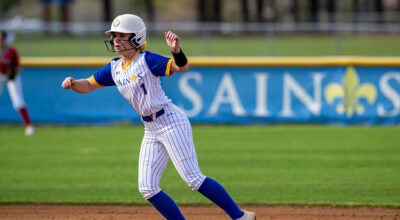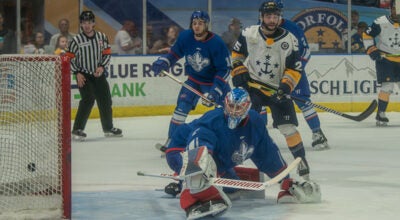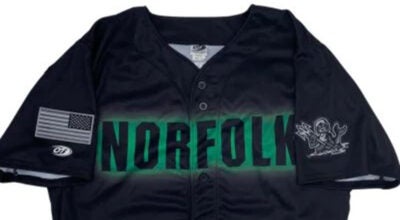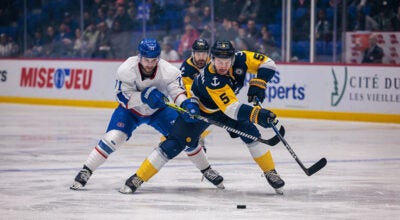Field hockey’s visionary debate
Published 10:44 pm Monday, November 3, 2008
The field hockey stick struck Ashley Alston and scraped across her eyeball in a flash, her eyelid reflexively closing around the stick’s bottom edge before it pulled free and smashed into her brow. Falling to the ground, she shrieked as her Nansemond River teammates came running and the 1997 tournament game at a Maryland field slammed to a halt.
Clutching her face, Alston had a question for those who sought to comfort her: “Is my eye still there?”
It was, but the blow left scar tissue that Alston, now a King’s Fork Middle School teacher, still deals with 11 years later. The black speck she sees isn’t ever expected to disappear, but she rarely notices it now.
Alston was carried from the field that day by her coach, Bucky Payton. She lay pain-racked and retching in a hospital emergency room for an hour before being seen and needing seven stitches in her eyebrow. She wore a patch over the injured eye for several days and has it checked annually to make sure the scar tissue on its surface hasn’t spread. She continued to play field hockey, but her parents forced her to wear plastic goggles.
Despite what she endured, Alston doesn’t believe eye protection should be mandatory in high school field hockey. Neither does Payton, now a longtime referee. Yet the Tidewater Conference, which includes Nansemond-Suffolk Academy, requires its players wear a padded wire cage with a headband that covers the eyes, eyebrows and the upper cheek bones. Whether such “goggles” or shatterproof sunglasses designed for field hockey should be nationally mandated is a hot topic in the sport.
Most players don’t want to wear eye protection, and they’re backed by coaches like Lakeland’s Tara Worley and Nansemond-Suffolk’s Kathleen Hotte. Worley’s teams are regional title contenders every fall and Hotte was a Virginia Beach high school star. Raising the idea of mandatory eyewear around them elicits glares and shakes of the head and Payton, the former coach and current referee, thinks the idea’s ridiculous.
“More kids hurt their eyes climbing out of the bath tub than playing field hockey,” he said.
On the other side are concerned parents like Kevin Alston, father of Ashley and assistant superintendent of administrative services for Suffolk Public Schools. They’re joined by a host of medical professionals, including those in sports advisory roles at the state and national levels.
Any severe eye injury is one too many, eyewear backers argue, especially when protection is easily available and doesn’t alter the game. But it does alter the game, cry the critics, who also contend it makes players vulnerable to injuries via collisions and being unable to see approaching balls and sticks in their peripheral vision.
There are an estimated 40,000 sports-related eye injuries in the U.S. every year, according to the American Academy of Opthalmology, and 90 percent are preventable with the use of protective eyewear. Basketball and baseball lead the field in such injuries and field hockey is well down the list, despite the estimated 65,000 girls who play it at the high school level. It’s estimated that roughly a quarter of those players use eyewear.
There are plenty of close calls each season and a few of them have occurred recently in Suffolk. In one of them, a member of Nansemond River’s JV team suffered a severe black eye last month after being struck by a ball, prompting her and several teammates to don goggles.
Megan Johnson, a member of Lakeland’s varsity, carries a small scar near the outer corner of her left eye, a reminder that she needed five stitches after getting struck by a stick during a summer league game. A former teammate, Sarah Mazzone, had her nose broken by a stick during an indoor game before she graduated earlier this year.
Johnson has carried on without eye protection, noting “that kind of thing happens only once in a blue moon.” She said her father initially pushed for her to don eyewear after the injury but has relented.
King’s Fork’s Rachael Fiel was struck twice in the head by sticks early this season, suffering a concussion because of one of the blows. She took to wearing the cage-style goggles, even though such masks are technically designed for women’s lacrosse, a game where the ball is in the air most of the time. Wearing them means Fiel has a harder time seeing balls at her feet, but she wasn’t willing to risk eye injury any longer.
“You don’t want to wear it until you’ve been hit and scared,” Fiel said.
No public school athletic districts in Virginia mandate field hockey eyewear. The Virginia High School League doesn’t do so because it doesn’t believe the cage-style goggles are specific enough to field hockey and because the National Federation of State High School Associations defines eyewear as optional equipment. Five states — Massachusetts, New Jersey, Connecticut, Rhode Island and Maine — have rules requiring field hockey eyewear.
The vast majority of Suffolk players and those throughout Hampton Roads don’t wear eye protection, but it’s creeping into the local game little by little. An educated guess from this season would be that roughly a dozen Southeastern District varsity players were willing to don the wire masks or the more stylish, shatterproof sunglasses that protect only the eyes and not the areas around them.
That urge, however, usually isn’t coming from the players’ coaches. Lakeland’s Worley and NSA’s Hotte are strongly against mandating eyewear and NR’s Darryl Yandle and KF’s Jessica Neblett are neutral on the topic. All four coaches are open to players being able to wear eye protection voluntarily.
“Sometimes we baby kids and this country wants to regulate everything,” said Worley, a former NR player in the early 1990s. “Nobody wants anything terrible to happen to anybody, but sometimes it does in sports. Football players fall down and aren’t able to walk again.”
Said Hotte: “If my team had the option of wearing (eye protection) or not, we would not wear it. Players who get hurt have usually put themselves in danger.”
Yandle concedes eye protection is probably a good idea. But he’s not campaigning for it and he allowed his daughter to play for him without eye protection several years ago.
Neblett said she’s undecided on the topic, but her predecessor did all she could to make Bulldog players aware of the risk. That predecessor was Ashley Alston, who was the program’s first coach and who gave her team a small speech before each season began.
“I told them about my injury and what I wore after it and I would suggest to them that they wear something,” said Alston, who played college field hockey at Ferrum and Christopher Newport with her shatterproof glasses. “I wore my protective glasses in practice when I played with the King’s Fork girls. I didn’t convince everybody, but I did convince one player.”
That was Kathryn Babineau, a KF defender and the class of 2008’s valedictorian. But as much as Alston put the issue of eye protection front and center, she’s against mandating it because she believes use should be a decision made by a player and their parents and because the cage-style masks limit a player’s peripheral vision.
That argument is the main one put forth by those opposed to mandating field hockey eye wear. And no one seems to argue that a player’s ability to see and sense what’s going on around them is reduced to some degree by wearing goggles.
“You have to have good communication with your teammates,” said NSA’s Brett Gwaltney. “They have to yell and let you know if (an opponent) is coming up from the back or the sides, because you can’t see that when you’re looking straight ahead or down at the ground.”
Supporters of mandating eye protection counter that the real effects are minimal on both the players and the game and that it’s a small price to pay to save someone’s sight.
“When they put shin guards on soccer players 25 years ago, it was said the guards would slow players down,” said Chad Byler, a certified athletic trainer and Norfolk Academy’s associate director of athletics. He and his school were the major force behind the TCIS mandating field hockey eyewear.
“Mouth guards came into field hockey at about the same time and some people were insistent the players couldn’t talk or breathe with them,” Byler continued. “It’s amazing the excuses that come up.”
Another example in support of Byler might be the professional American Hockey League, which includes the Norfolk Admirals.
After an AHL player lost sight in an eye during 2006 because of a deflected puck, the league mandated that plastic visors be attached to the front of all helmets and extend down to the nose area. Despite tremendous initial resistance from many players, there’s no evidence that the quality of AHL play has declined or that its players have been prone to injuries caused by a loss of peripheral vision.
Another argument by anti-eyewear forces is that strict enforcement of field hockey rules and proper attention to teaching techniques are sufficient prevention against injury. Rules have been tweaked in recent years to provide more space between players taking free hits and others on the field, but airborne passes are also now allowed if the referee deems them to not endanger other competitors.
Knowledgeable coaches teach players how to defend without placing themselves in the range of an opponent’s front or back swings. It’s a point of emphasis for NR’s coaching staff and its players, who saw Indian River’s Rosemary Willis suffer a deep cut near her eye when she ran into a Warrior’s swing last season.
“You have to make sure your stick doesn’t allow the ball to ramp up at you,” said NR assistant coach Caron Lowe. “When defenders do reach in, they have to keep their shoulders back and not lunge. Keeping your face out of the line of fire is always the most important thing.”
That’s fine for veteran players on smooth fields, say protection advocates. But what happens when inexperienced varsity players or whole teams of them at the JV level clash on fields full of rises, depressions, bald spots and protruding tufts of grass? There are several such facilities in the Southeastern District.
Hotte said she told her players to back off opponents’ swings during a preseason game this year because the other team’s players were new to the sport and flailed wildly with their sticks. The same quiet advice is sometimes heard when accomplished teams like Lakeland or NR play district opponents like Indian River or Deep Creek, whose players are often new to the game.
Dr. Vito Periello is a Charlottesville pediatrician who’s practiced for 39 years, works with athletic teams at St. Anne’s-Belfield School, is the father to two former high school field hockey players and chairs the Virginia High School League’s sports medicine advisory committee. Periello said the field hockey establishment’s argument that it can legislate away the risk of serious eye injuries has fallen flat.
“They’ve had years to develop more points of emphasis with referees but the game and the girls playing it have changed,” said Periello, going on to describe how much faster and stronger today’s players are and how composite sticks have added to the speed with which players swing and balls fly.
“What they’re doing is using innuendo and emotion to try and counteract data. Unequivocally the injuries are there without (eye protection) and gone with it and that makes it a no-brainer to me.”
Periello said his committee and the one advising high school sports’ national governing body have each recommended mandating field hockey eyewear for several years.
“It’s very difficult when a medical group says something will make your sport safer and you don’t do it,” Periello said. “There are legal consequences that eventually come around. But the executive committees that pass the rules at the state and national levels have been influenced by field hockey’s old guard, which is totally against (mandated eye protection).”
In 2000, a former Connecticut field hockey player was awarded $900,000 after losing much of her vision in one eye because of a teammate’s stick at practice. Players in New Jersey and Maine also lost sight in field hockey accidents in recent years.
Byler said that in the three years before the TCIS mandated protective eyewear for field hockey in 1999, he documented nine eye and/or facial injuries to Norfolk Academy players. He said no Academy player has suffered one since and players, parents and coaches who resisted the change became staunch advocates for his point of view.
“Five years ago, I thought it would significantly change the game,” Norfolk Academy coach Mary Werkheiser told The Virginian-Pilot in 2004. “But it hasn’t.”
One more argument put forth against eyewear is that it’s rarely used in collegiate field hockey or on the international stage. But games at those levels are almost always played on fields of smooth, artificial turf and players have better control of their sticks, passes and shots than high school athletes.
Periello thinks mandatory eyewear will arrive in field hockey in the near future. He notes that similar resistance to it in girls lacrosse and to safely controlling weight in wrestling was slowly overcome and is now widely accepted.
“The argument that finally holds the day is that, regardless of the incidence, it’s unacceptably high if catastrophic injury can occur and it can be easily prevented,” he said. “People eventually come around.”






